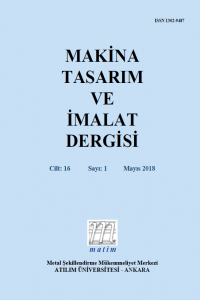Öz
3 boyutlu yazıcılar aracılığıyla üretilen
bileşenler ve ürünler, otomotiv, biyomedikal, tekstil ve gıda sektörlerinde
giderek artan oranda kullanılmaktadır. Bu yöntemle üretilen malzemelerin
mekanik özelliklerinin anlaşılması, bu malzemelerin uygulamalarda verimli
olarak kullanılması açısından önem taşımaktadır. Bu çalışmada en yaygın olarak kullanılan
3 boyutlu yazıcı malzemelerinden biri olan polilaktik asit ile üretilen
yapılarda, nozul sıcaklığı ve dolgu yoğunluğu gibi parametrelerin mekanik
özelliklere etkisi incelenmiştir. Nozul sıcaklığı arttıkça üst çekme dayanımı
artmış, dolgu yoğunluğu azaldıkça dayanım ve elastikiyet modülü kademeli olarak
azalmıştır. Elde edilen bulgular, üç boyutlu yazıcı ürünü yapıların mekanik
özellik, üretim süresi ve maliyet açısından optimize edilmesine rehber olacak
niteliktedir.
Anahtar Kelimeler
eklemeli üretim mekanik özellikler polilaktik asit eriyik yığma modelleme
Kaynakça
- 1. I. Gibson, D. Rosen, B. Stucker, Additive Manufac- turing Technologies: 3D Printing, Rapid Prototyping, and Direct Digital Manufacturing, 2nd ed., Springer-Verlag, New York, 2015.
- 2. S.H. Huang, P. Liu, A. Mokasdar, L. Hou, Additive manufacturing and its societal impact: a literature review, Int J Adv Manuf Technol., 2013, 67:1191–1203.
- 3. W. E. Frazier, Metal additive manufacturing: A re- view, J of Materials Eng. and Performance, 2014, 23(6): 1917-1928.
- 4. M. Skorski, J. Esenther, Z. Ahmed, A.E. Miller, M.R. Hartings, The chemical, mechanical, and physical properties of 3D printed materials composed of TiO2-ABS nanocomposites, Sci Technol Adv Mater. 2016, 17: 89–97.
- 5. T. Tabi, I.E. Sajo, F. Szabo, A.S. Luyt, J.G. Kovacs, Crystalline structure of annealed polylactic acid and its relation to processing, Express Polymer Letters. 2010,4 :659–668.
- 6. B.M. Tymrak, M. Kreiger, J.M. Pearce, Mechanical properties of components fabricated with open-source 3-D printers under realistic environmental conditions, Materials & Design. ,2014, 58: 242–246.
- 7. B. Wittbrodt, J.M. Pearce, The effects of PLA color on material properties of 3-D printed components, Additive Manufacturing. 2015, 8: 110–116.
- 8. L.J. Gibson and M.F. Ashby, Cellular Solids: Struc-ture and Properties, 2nd ed., Cambridge University Press, Cambridge, 1997.
Öz
Kaynakça
- 1. I. Gibson, D. Rosen, B. Stucker, Additive Manufac- turing Technologies: 3D Printing, Rapid Prototyping, and Direct Digital Manufacturing, 2nd ed., Springer-Verlag, New York, 2015.
- 2. S.H. Huang, P. Liu, A. Mokasdar, L. Hou, Additive manufacturing and its societal impact: a literature review, Int J Adv Manuf Technol., 2013, 67:1191–1203.
- 3. W. E. Frazier, Metal additive manufacturing: A re- view, J of Materials Eng. and Performance, 2014, 23(6): 1917-1928.
- 4. M. Skorski, J. Esenther, Z. Ahmed, A.E. Miller, M.R. Hartings, The chemical, mechanical, and physical properties of 3D printed materials composed of TiO2-ABS nanocomposites, Sci Technol Adv Mater. 2016, 17: 89–97.
- 5. T. Tabi, I.E. Sajo, F. Szabo, A.S. Luyt, J.G. Kovacs, Crystalline structure of annealed polylactic acid and its relation to processing, Express Polymer Letters. 2010,4 :659–668.
- 6. B.M. Tymrak, M. Kreiger, J.M. Pearce, Mechanical properties of components fabricated with open-source 3-D printers under realistic environmental conditions, Materials & Design. ,2014, 58: 242–246.
- 7. B. Wittbrodt, J.M. Pearce, The effects of PLA color on material properties of 3-D printed components, Additive Manufacturing. 2015, 8: 110–116.
- 8. L.J. Gibson and M.F. Ashby, Cellular Solids: Struc-ture and Properties, 2nd ed., Cambridge University Press, Cambridge, 1997.
Ayrıntılar
| Birincil Dil | Türkçe |
|---|---|
| Konular | Makine Mühendisliği |
| Bölüm | Araştırma Makalesi |
| Yazarlar | |
| Yayımlanma Tarihi | 16 Mayıs 2019 |
| Gönderilme Tarihi | 5 Temmuz 2018 |
| Yayımlandığı Sayı | Yıl 2018 Cilt: 16 Sayı: 1 |

